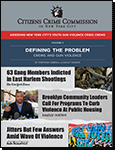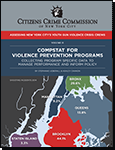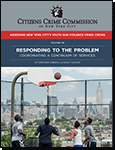
|
A non-partisan non-profit organization working to make criminal justice and public safety policies and practices more effective through innovation, research, and education. |
INITIATIVE Gang and Group Violence Prevention Assessing New York City's Youth Gun Violence Crisis: Crews The success or failure of community strategies to address the youth gun violence crisis is often attributed in part to how well the problem is understood and diagnosed. With support from The New York Community Trust, the Crime Commission has undertaken an analysis of youth gun violence and crew activity — violent turf rivalries among less-organized, smaller and normally younger groups than traditional gangs — in select New York City communities. Our initial findings from available data, existing research, and interviews with stakeholders are presented in a series of papers titled, "Assessing New York City's Youth Gun Violence Crisis: Crews". New York City has famously experienced unprecedented, sustained reductions in crime over the last 25 years. Areas once so dangerous that they resembled foreign war zones now are home to some of the most desirable real estate in the country. We proudly and rightfully point to our success, calling ourselves the "safest big city in America". But there are places and people that have been left behind. There are areas which have not seen violent crime rates drop to nearly zero — as others have — or anywhere close. Certain races and age groups are also still far more likely to become victims and be responsible for violent crime than others. The root causes of violent crime have not changed either—and the circumstances under which crime is committed sound eerily familiar to the high-crime New York of 25 years ago that we now refer to as the "bad old days". Therefore, in order to make real strides in improving the quality of life amongst these persistently hardest-hit groups, we must address the root causes of why youth become involved in gun violence and crews. The NYPD publically acknowledged that youth "gangs" are becoming more organized and more violent, finding that more than a third of all shootings in New York City now involve what the NYPD calls "crews". In order to truly identify how youth are involved in organized activity (gangs, crews, etc.) and gun violence, the Crime Commission researched legal and intelligence definitions and conducted fieldwork with community residents, service providers, and policymakers which revealed three broad categories of organization: TRADITIONAL GANGS Groups that have clear hierarchy, structure, organization, rules of conduct and are profit-motivated, usually affiliating with national gangs such as the Bloods. CREWS Fluid groups formed based on where members live, such as a building or block, creating violent turf rivalries. Crews generally do not have clear hierarchy, structure, or rules, and are usually not profit-motivated. GROUPS Unorganized groups, often temporal in nature, which form as a result of interpersonal conflicts. This research and fieldwork demonstrated that crews — and not traditional, hierarchical gangs — are a major part of violent crime statistics and analysis. Crews actually account for a great deal of youth criminal activity, especially violent crime — and without proper interventions for this type of activity, we will not be able to adequately address what has been a persistent public safety and criminal justice issue for New York City. In order to develop more effective responses to crews it is essential for stakeholders to acknowledge the victimization of those involved, understand their underlying needs, and identify the neighborhood conditions that impact them. 
Although there have been significant recent investments by policymakers and funders — ranging from organizing task forces and work groups, to deploying new law enforcement strategies, to implementing programmatic interventions — New York City's ability to fully understand and diagnose its crew problem is hindered by a lack of data and coordination. While the NYPD collects data on crew members and related criminal activity, law enforcement data are typically insufficient to inform comprehensive responses because it is collected for the purpose of informing suppression and investigation strategies. At the same time, community-based organizations collect a range of data about the underlying needs of the individuals involved, but often lack the capacity to analyze and communicate these data to inform policy and programming decisions. Further, the City lacks a collaborative effort among stakeholders dedicated to addressing this problem. Preventing crew violence cannot be accomplished by a single agency or organization. Effective solutions require the combination of insight, hard work, and dedication from a wide variety of organizations and stakeholders. New York City should immediately mobilize stakeholders to take steps toward developing a comprehensive strategy to address the city's crew violence problem. The Crime Commission's Assessment Offers The Following Recommendations: Implement A Collaborative Approach:
As youth develop their identity, set goals, and plan for their future they stop committing crime. By implementing these suggestions, the city can build comprehensive strategies that reduce crew violence and make our communities safer. |
Media & Resources
Reports
|


